 y.layout.CanonicMultiStageLayouter
y.layout.CanonicMultiStageLayouter
 y.layout.orthogonal.DirectedOrthogonalLayouter
y.layout.orthogonal.DirectedOrthogonalLayouter
|
Search this API | ||||||||
| PREV CLASS NEXT CLASS | FRAMES NO FRAMES | ||||||||
| SUMMARY: NESTED | FIELD | CONSTR | METHOD | DETAIL: FIELD | CONSTR | METHOD | ||||||||
java.lang.Objecty.layout.CanonicMultiStageLayouter
y.layout.orthogonal.DirectedOrthogonalLayouter
public class DirectedOrthogonalLayouter
This layout algorithm arranges directed graphs in an orthogonal fashion.
This layout algorithm arranges the elements of a given graph such that each edge is drawn as an alternating sequence of horizontal and vertical segments. Furthermore, all directed edges point to the main layout orientation. Edges that connect to the same node can also be routed in a bus-like structure.
The layout algorithm is well suited for small and medium-sized sparse graphs and produces drawings with no overlapping nodes, few crossings and few bends. Application domains of directed orthogonal drawings include, for example, software engineering, database schema and system management.
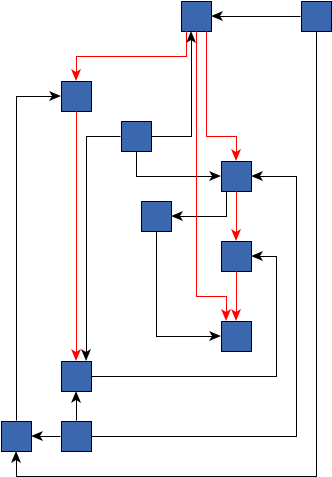
DirectedOrthogonalLayouter with default settings. Marked edges are considered as directed
and the layout orientation is top-to-bottom.
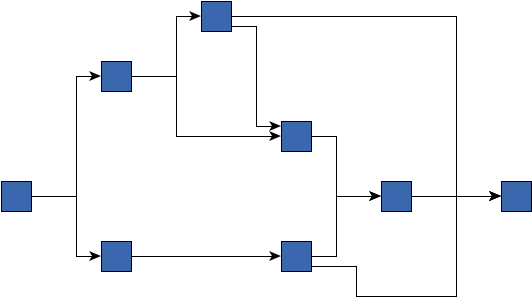
DirectedOrthogonalLayouter with edge grouping. All edges are considered directed and the
layout orientation is left-to-right.
The directed orthogonal layout algorithm is based on the topology-shape-metrics approach and runs in three phases:
Each of the phases has to consider the edge direction.
The layout algorithm is able to handle both directed and undirected edges.
All directed edges are routed such that they point to the main layout orientation. They should be marked by means of a DataProvider registered with key DIRECTED_EDGE_DPKEY.
Edges can be grouped so that they share common segments at the beginning or end of their routes. Although a graph
may contain source and target grouped edges, an edge can only be part of either a source or a target group. Edge groups
are specified using DataProviders that provide the same ID object for all edges of the same group. Those
DataProviders are registered with the graph with key PortConstraintKeys.SOURCE_GROUPID_KEY for source
groups or key PortConstraintKeys.TARGET_GROUPID_KEY for target groups.
EdgeLayoutDescriptor instances can be used for specifying individual information (e.g. minimum lengths) for each
edge in the graph. The descriptors are bound to the graph using a DataProvider registered with key
EDGE_LAYOUT_DESCRIPTOR_DPKEY.
If there is no descriptor assigned to some edges, the
default descriptor will be used.
DirectedOrthogonalLayouter is able to consider edge label data when arranging a graph. This means that the
layout algorithm will determine the positions of the nodes and edges such that the edge labels do not overlap with
the other elements. Integrated edge labeling can be activated using method
setIntegratedEdgeLabelingEnabled(boolean).
This layout algorithm is able to detect substructures in the input graph. If desired, it can handle and arrange
them explicitly, making the structure easy to recognize. Supported substructures are trees, chains and cycles.
See the corresponding style properties for details: setTreeStyle(byte), setChainStyle(byte)
and setCycleStyle(byte).
For the detection of substructures, it is optionally possible to consider
node types, such that only nodes of the same user-defined type
can form a substructure.
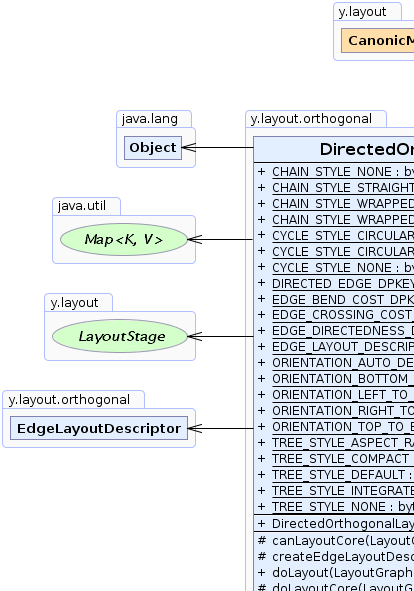 |
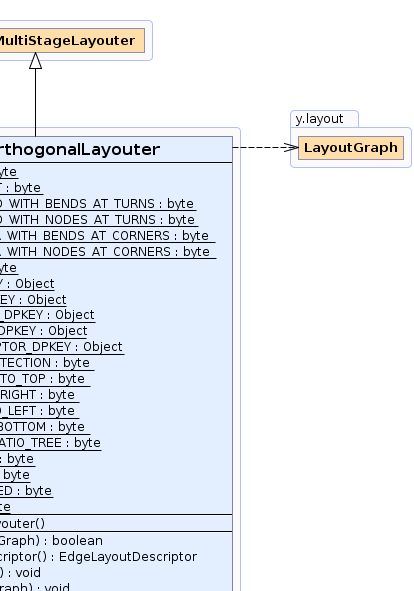 |
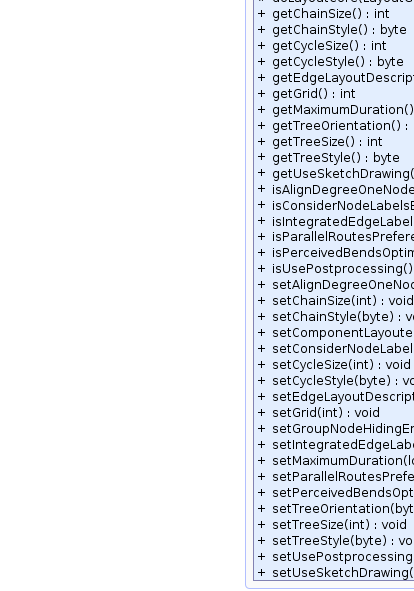 |
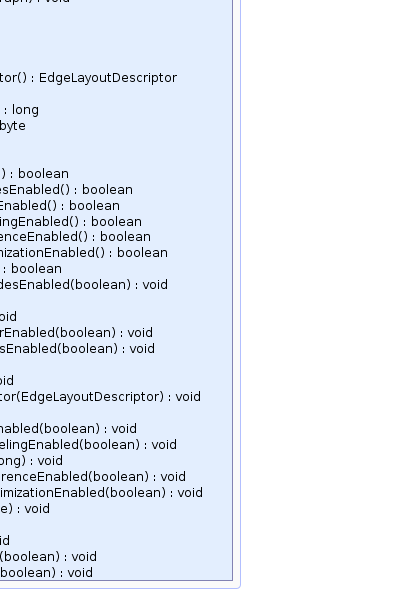 |
| Field Summary | |
|---|---|
static byte |
CHAIN_STYLE_NONE
A chain layout style that defines that chains should not be handled specifically. |
static byte |
CHAIN_STYLE_STRAIGHT
A chain layout style that defines that chains are arranged in a straight fashion. |
static byte |
CHAIN_STYLE_WRAPPED_WITH_BENDS_AT_TURNS
A chain layout style that defines that chains are line/column wrapped such that bends of the chain edges form the turns/corners of the chain arrangement. |
static byte |
CHAIN_STYLE_WRAPPED_WITH_NODES_AT_TURNS
A chain layout style that defines that chains are line/column-wrapped such that nodes form the turns/corners of the chain arrangement. |
static byte |
CYCLE_STYLE_CIRCULAR_WITH_BENDS_AT_CORNERS
A cycle layout style that defines that cycle structures are arranged in a circular fashion such that bends of cycle edges form the corners of the circular layout. |
static byte |
CYCLE_STYLE_CIRCULAR_WITH_NODES_AT_CORNERS
A cycle layout style that defines that cycle structures are arranged in a circular fashion such that nodes form the corners of the circular layout. |
static byte |
CYCLE_STYLE_NONE
A cycle layout style that defines that cycles should not be handled specifically. |
static java.lang.Object |
DIRECTED_EDGE_DPKEY
A DataProvider key for marking edges which should be routed such that they point to the main layout orientation
The main layout orientation can be set using method CanonicMultiStageLayouter.setLayoutOrientation(byte). |
static java.lang.Object |
EDGE_BEND_COST_DPKEY
A DataProvider key for providing bend costs for each edge
The layout algorithm considers the specified costs
during the bend minimization phase. |
static java.lang.Object |
EDGE_CROSSING_COST_DPKEY
A DataProvider key for providing crossing costs for each edge
The layout algorithm considers the specified
costs during the crossing minimization phase. |
static java.lang.Object |
EDGE_DIRECTEDNESS_DPKEY
A DataProvider key for specifying the directedness of edges for the detection of substructures
The edge directedness is considered for the detection of substructures in the input graph
i.e., trees, chains and cycles. |
static java.lang.Object |
EDGE_LAYOUT_DESCRIPTOR_DPKEY
A DataProvider key for providing layout information for each edge
If no edge layout descriptor is mapped to an edge, the
default edge layout descriptor will be used. |
static byte |
ORIENTATION_AUTO_DETECTION
Orientation specifier that defines that the layout orientation of substructures is chosen automatically. |
static byte |
ORIENTATION_BOTTOM_TO_TOP
Orientation specifier that defines that the layout orientation of substructures is bottom to top. |
static byte |
ORIENTATION_LEFT_TO_RIGHT
Orientation specifier that defines that the layout orientation of substructures is left to right. |
static byte |
ORIENTATION_RIGHT_TO_LEFT
Orientation specifier that defines that the layout orientation of substructures is right to left. |
static byte |
ORIENTATION_TOP_TO_BOTTOM
Orientation specifier that defines that the layout orientation of substructures is top to bottom. |
static byte |
TREE_STYLE_ASPECT_RATIO_TREE
A tree layout style that yields tree layouts with an aspect ratio close to 1:1 that
are generated by ARNodePlacer. |
static byte |
TREE_STYLE_COMPACT
A tree layout style that aims to create maximally compact layouts for the subtrees by using the CompactNodePlacer for the tree layout algorithm. |
static byte |
TREE_STYLE_DEFAULT
A tree layout style that arranges subtrees in a layered tree fashion with grouped edge routes, generated by a DefaultNodePlacer with routing style
DefaultNodePlacer.ROUTING_FORK
and alignment setting DefaultNodePlacer.ALIGNMENT_CENTER. |
static byte |
TREE_STYLE_INTEGRATED
A tree layout style that arranges subtrees in a layered tree fashion with grouped edge routes and integrates the tree elements into the orthogonal layout framework. |
static byte |
TREE_STYLE_NONE
A tree layout style that defines that subtrees should not be handled specifically. |
| Fields inherited from interface y.layout.Layouter |
|---|
EDGE_ID_DPKEY, NODE_ID_DPKEY, NODE_TYPE_DPKEY, SELECTED_EDGES, SELECTED_NODES |
| Constructor Summary | |
|---|---|
DirectedOrthogonalLayouter()
Creates a new DirectedOrthogonalLayouter instance with default settings. |
|
| Method Summary | |
|---|---|
protected boolean |
canLayoutCore(LayoutGraph graph)
Accepts general graphs without exceptions. |
protected EdgeLayoutDescriptor |
createEdgeLayoutDescriptor()
Returns a new EdgeLayoutDescriptor instance that will be used during the various phases of the layout
algorithm to determine the drawing details of the edges of the graph. |
void |
doLayout(LayoutGraph graph)
Calculates a directed orthogonal layout for the given graph taking the specified layout orientation into consideration. |
protected void |
doLayoutCore(LayoutGraph graph)
Calculates a directed orthogonal layout for the given graph. |
int |
getChainSize()
Returns the minimum size (number of nodes) a chain needs to have to be detected and handled as a chain substructure. |
byte |
getChainStyle()
Returns the chain layout style that defines how chain substructures are arranged. |
int |
getCycleSize()
Returns the minimum size (number of nodes) a cycle needs to have to be detected and explicitly handled as a cycle substructure. |
byte |
getCycleStyle()
Returns the cycle layout style that defines how cycle substructures are arranged. |
EdgeLayoutDescriptor |
getEdgeLayoutDescriptor()
Returns the EdgeLayoutDescriptor instance used for all those edges that do not have a
specific layout descriptor assigned. |
int |
getGrid()
Returns the equidistant spacing between the horizontal and vertical grid lines. |
long |
getMaximumDuration()
Returns the preferred time limit in milliseconds. |
byte |
getTreeOrientation()
Returns the desired orientation for subtree layouts. |
int |
getTreeSize()
Returns the minimum size (number of nodes) a subtree needs to have to be detected and explicitly handled as a tree substructure. |
byte |
getTreeStyle()
Returns the tree layout style that defines the basic arrangement style for subtrees. |
boolean |
getUseSketchDrawing()
Returns whether or not the existing drawing should be used as a sketch for the resulting orthogonal layout. |
boolean |
isAlignDegreeOneNodesEnabled()
Returns whether or not degree-one nodes that have the same neighbor should be aligned. |
boolean |
isConsiderNodeLabelsEnabled()
Returns whether or not the layout algorithm considers node labels when calculating node positions to avoid overlaps. |
boolean |
isIntegratedEdgeLabelingEnabled()
Returns whether or not the layout algorithm preserves space and places edge labels. |
boolean |
isParallelRoutesPreferenceEnabled()
Returns whether or not parallel routes for parallel edges (multi-edges) are preferred over independent routes. |
boolean |
isPerceivedBendsOptimizationEnabled()
Returns whether or not the number of perceived bends will be minimized. |
boolean |
isUsePostprocessing()
Returns whether or not an additional postprocessing step that improves compactness and reduces the number of bends should be applied. |
void |
setAlignDegreeOneNodesEnabled(boolean alignDegreeOneNodesEnabled)
Specifies whether or not degree-one nodes that have the same neighbor should be aligned. |
void |
setChainSize(int chainSize)
Specifies the minimum size (number of nodes) a chain needs to have to be detected and handled as a chain substructure. |
void |
setChainStyle(byte chainStyle)
Specifies the chain layout style that defines how chain substructures are arranged. |
void |
setComponentLayouterEnabled(boolean enabled)
Specifies whether or not the LayoutStage used for arranging the components of the graph is activated. |
void |
setConsiderNodeLabelsEnabled(boolean enabled)
Specifies whether or not the layout algorithm considers node labels when calculating node positions to avoid overlaps. |
void |
setCycleSize(int cycleSize)
Specifies the minimum size (number of nodes) a cycle needs to have to be detected and explicitly handled as a cycle substructure. |
void |
setCycleStyle(byte cycleStyle)
Specifies the cycle layout style that defines how cycle substructures are arranged. |
void |
setEdgeLayoutDescriptor(EdgeLayoutDescriptor edgeLayoutDescriptor)
Specifies the EdgeLayoutDescriptor instance used for all those edges that do not have a
specific layout descriptor assigned. |
void |
setGrid(int grid)
Specifies the equidistant spacing between the horizontal and vertical grid lines. |
void |
setGroupNodeHidingEnabled(boolean groupNodeHidingEnabled)
Specifies whether or not the LayoutStage used for hiding group nodes is activated. |
void |
setIntegratedEdgeLabelingEnabled(boolean enabled)
Specifies whether or not the layout algorithm preserves space and places edge labels. |
void |
setMaximumDuration(long maximumDuration)
Specifies the preferred time limit in milliseconds. |
void |
setParallelRoutesPreferenceEnabled(boolean parallelRoutesPreferenceEnabled)
Specifies whether or not parallel routes for parallel edges (multi-edges) are preferred over independent routes. |
void |
setPerceivedBendsOptimizationEnabled(boolean perceivedBendsOptimizationEnabled)
Specifies whether or not the number of perceived bends will be minimized. |
void |
setTreeOrientation(byte treeOrientation)
Specifies the desired orientation for subtree layouts. |
void |
setTreeSize(int treeSize)
Specifies the minimum size (number of nodes) a subtree needs to have to be detected and explicitly handled as a tree substructure. |
void |
setTreeStyle(byte treeStyle)
Specifies the tree layout style that defines the basic arrangement style for subtrees. |
void |
setUsePostprocessing(boolean usePostprocessing)
Specifies whether or not an additional postprocessing step that improves compactness and reduces the number of bends should be applied. |
void |
setUseSketchDrawing(boolean value)
Specifies whether or not the existing drawing should be used as a sketch for the resulting orthogonal layout. |
| Methods inherited from class java.lang.Object |
|---|
clone, equals, finalize, getClass, hashCode, notify, notifyAll, toString, wait, wait, wait |
| Field Detail |
|---|
public static final java.lang.Object EDGE_LAYOUT_DESCRIPTOR_DPKEY
DataProvider key for providing layout information for each edge
If no edge layout descriptor is mapped to an edge, the
default edge layout descriptor will be used.
Different settings will affect the routing of the edges during the layout.
public static final java.lang.Object EDGE_DIRECTEDNESS_DPKEY
DataProvider key for specifying the directedness of edges for the detection of substructures
The edge directedness is considered for the detection of substructures in the input graph
i.e., trees, chains and cycles.
A substructure is only identified as such if all edges are either undirected or consistently directed
with respect to the specified directedness.
1 indicates that the edge is considered to be
directed from source to target.
-1 indicates that the edge is considered to be
directed from target to source.
0 indicates that the edge is considered to be
undirected.
DataProvider is registered with this key, all edges are treated as undirected.DIRECTED_EDGE_DPKEY. The latter
one marks edges that are directed orthogonal and shall point in the specified
layout orientation. On the other hand, this key is only
responsible for the specification of the directedness with respect to the substructure detection.public static final java.lang.Object EDGE_CROSSING_COST_DPKEY
DataProvider key for providing crossing costs for each edge
The layout algorithm considers the specified
costs during the crossing minimization phase. Edges with lower costs are more likely to have crossings.
If no individual costs are defined, each crossing has a cost of 1.
public static final java.lang.Object EDGE_BEND_COST_DPKEY
DataProvider key for providing bend costs for each edge
The layout algorithm considers the specified costs
during the bend minimization phase. Edges with lower costs are more likely to have bends.
If no individual costs are defined, each bend has a cost of 1.
public static final java.lang.Object DIRECTED_EDGE_DPKEY
DataProvider key for marking edges which should be routed such that they point to the main layout orientation
The main layout orientation can be set using method CanonicMultiStageLayouter.setLayoutOrientation(byte).
public static final byte TREE_STYLE_NONE
Subtrees are not detected and will be arranged without specific emphasis of the tree structure.
setTreeStyle(byte),
Constant Field Values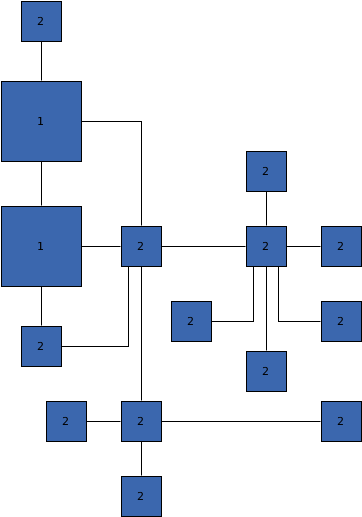 Tree style TREE_STYLE_NONE |
public static final byte TREE_STYLE_DEFAULT
DefaultNodePlacer with routing style
DefaultNodePlacer.ROUTING_FORK
and alignment setting DefaultNodePlacer.ALIGNMENT_CENTER.
Child nodes sharing the same parent node are placed next to each other above/below the root (vertical orientation) or above each other left/right of the root (horizontal orientation).
In contrast to TREE_STYLE_INTEGRATED this style produces more compact layout results. However, the
overall layout may be less homogeneous because the subtrees are separately arranged by a dedicated
tree layout algorithm which does e.g., not consider the specified grid.
setTreeStyle(byte),
Constant Field Values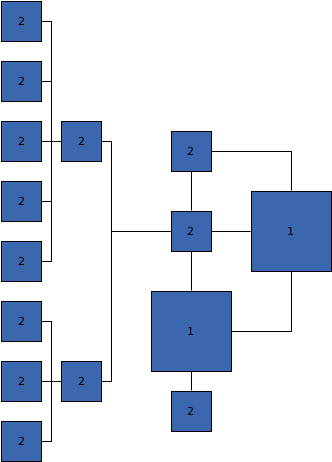 Tree style TREE_STYLE_DEFAULT |
public static final byte TREE_STYLE_INTEGRATED
Child nodes sharing the same parent node are placed next to each other above/below the root (vertical orientation) or above each other left/right of the root (horizontal orientation).
In contrast to TREE_STYLE_DEFAULT, the subtree elements are handled by the orthogonal layout framework
internally. This makes the final layout more homogeneous, but potentially less compact. Furthermore, the
grid will be correctly obeyed also for tree nodes.
setTreeStyle(byte),
Constant Field Values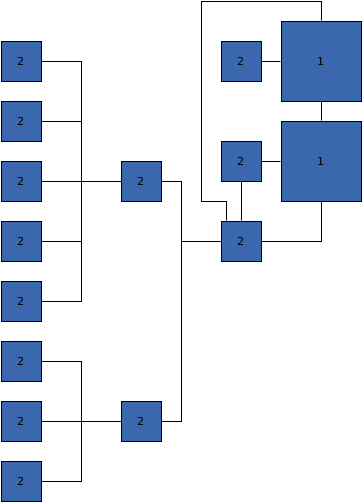 Tree style TREE_STYLE_INTEGRATED |
public static final byte TREE_STYLE_COMPACT
CompactNodePlacer for the tree layout algorithm.
The algorithm applied to the subtrees tries to combine different placement strategies such that the overall area required by subtrees is small. This means that the style of different tree structures can vary within the same layout.
setTreeStyle(byte),
Constant Field Values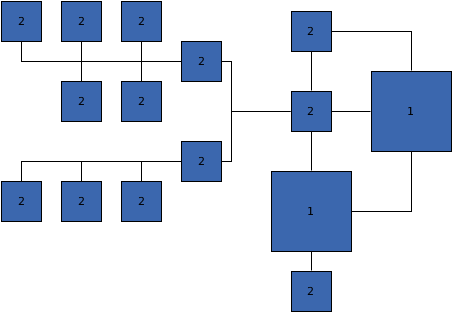 Tree style TREE_STYLE_COMPACT |
public static final byte TREE_STYLE_ASPECT_RATIO_TREE
1:1 that
are generated by ARNodePlacer.
To achieve the aspect ratio, tree child nodes are organized in as much rows/columns as needed. Edges are routed orthogonally along the rows/columns. The parent node of the children is placed in a corner besides the child nodes depending on the tree layout orientation, e.g., left above the child nodes for top-to-bottom orientation.
setTreeStyle(byte),
Constant Field Values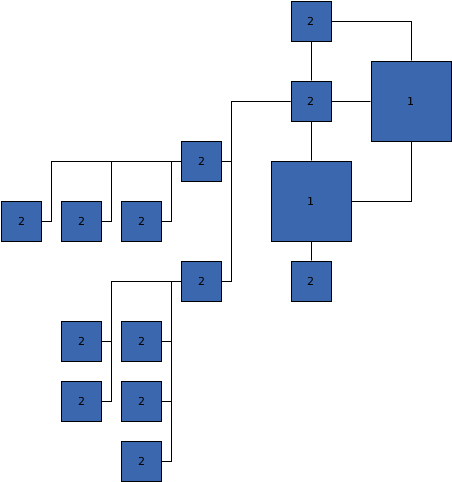 Tree style TREE_STYLE_ASPECT_RATIO_TREE |
public static final byte ORIENTATION_TOP_TO_BOTTOM
setTreeOrientation(byte),
Constant Field Valuespublic static final byte ORIENTATION_BOTTOM_TO_TOP
setTreeOrientation(byte),
Constant Field Valuespublic static final byte ORIENTATION_LEFT_TO_RIGHT
setTreeOrientation(byte),
Constant Field Valuespublic static final byte ORIENTATION_RIGHT_TO_LEFT
setTreeOrientation(byte),
Constant Field Valuespublic static final byte ORIENTATION_AUTO_DETECTION
The automatic orientation selection is made e.g., by searching a side at the root node were no edge connects yet and inserting the substructure at that side using the respective orientation (for example, right side means left-to-right layout). It is recommended to use this setting if layouts should be maximally compact, because specifying a fixed orientation reduces the degree of freedom of the algorithm.
setTreeOrientation(byte),
Constant Field Valuespublic static final byte CHAIN_STYLE_NONE
Chains in the input graph are not detected and will be arranged without specific emphasis of the chain structure.
setChainStyle(byte),
Constant Field Values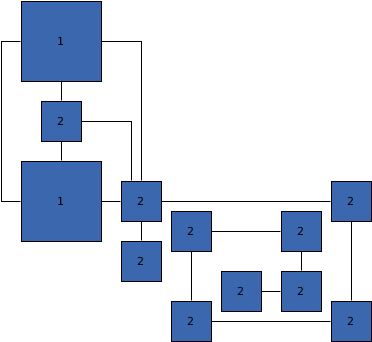 Chains are not handled explicitly ( CHAIN_STYLE_NONE) |
public static final byte CHAIN_STYLE_STRAIGHT
setChainStyle(byte),
Constant Field Values Chain layout style CHAIN_STYLE_STRAIGHT |
public static final byte CHAIN_STYLE_WRAPPED_WITH_NODES_AT_TURNS
setChainStyle(byte),
Constant Field Values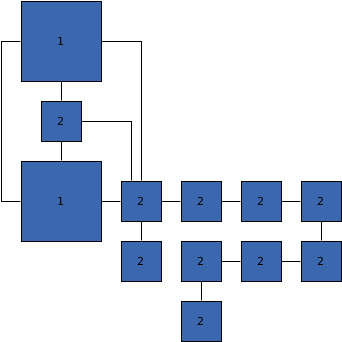 Chain layout style CHAIN_STYLE_WRAPPED_WITH_NODES_AT_TURNS |
public static final byte CHAIN_STYLE_WRAPPED_WITH_BENDS_AT_TURNS
setChainStyle(byte),
Constant Field Values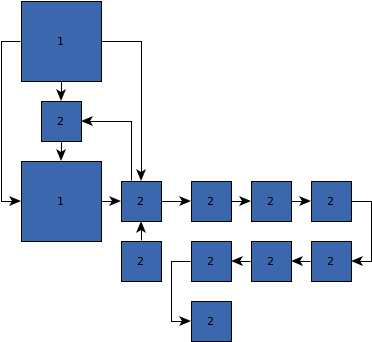 Chain layout style CHAIN_STYLE_WRAPPED_WITH_BENDS_AT_TURNS |
public static final byte CYCLE_STYLE_NONE
Cycles in the input graph are not detected and will be arranged without specific emphasis of the cycle structure.
setCycleStyle(byte),
Constant Field Values Cycle not handled specifically ( CYCLE_STYLE_NONE) |
public static final byte CYCLE_STYLE_CIRCULAR_WITH_NODES_AT_CORNERS
setCycleStyle(byte),
Constant Field Values Cycle layout style CYCLE_STYLE_CIRCULAR_WITH_NODES_AT_CORNERS |
public static final byte CYCLE_STYLE_CIRCULAR_WITH_BENDS_AT_CORNERS
setCycleStyle(byte),
Constant Field Values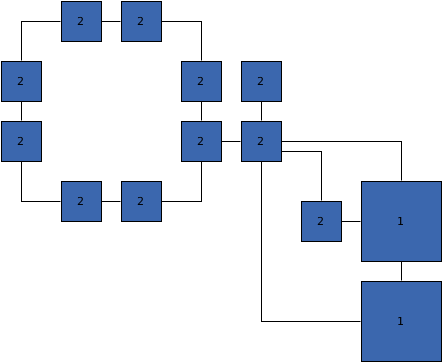 Cycle layout style CYCLE_STYLE_CIRCULAR_WITH_BENDS_AT_CORNERS |
| Constructor Detail |
|---|
public DirectedOrthogonalLayouter()
DirectedOrthogonalLayouter instance with default settings.
| Method Detail |
|---|
public long getMaximumDuration()
Depending on the specified value and the size of the input graph, the layout algorithm may automatically
disable properties setUsePostprocessing(boolean) and setPerceivedBendsOptimizationEnabled(boolean).
These properties improve the layout quality but also increase the runtime, especially for larger graphs.
If the time limit is set to Long.MAX_VALUE, the layout algorithm runs unrestricted.
Values have to be greater or equal to 0.
setMaximumDuration(long)public void setMaximumDuration(long maximumDuration)
Depending on the specified value and the size of the input graph, the layout algorithm may automatically
disable properties setUsePostprocessing(boolean) and setPerceivedBendsOptimizationEnabled(boolean).
These properties improve the layout quality but also increase the runtime, especially for larger graphs.
If the time limit is set to Long.MAX_VALUE, the layout algorithm runs unrestricted.
Values have to be greater or equal to 0.
Long.MAX_VALUE. The layout algorithm runs unrestricted.maximumDuration - a non-negative value that specifies the preferred time limit
java.lang.IllegalArgumentException - if the maximum duration is negativepublic boolean isAlignDegreeOneNodesEnabled()
true if the degree-one nodes are aligned, false otherwisesetAlignDegreeOneNodesEnabled(boolean)public void setAlignDegreeOneNodesEnabled(boolean alignDegreeOneNodesEnabled)
alignDegreeOneNodesEnabled - true if the degree-one nodes should be aligned, false
otherwise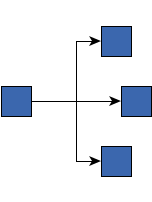 Degree-one nodes are not aligned and layout orientation is left-to-right | 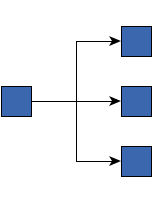 Degree-one nodes are aligned and layout orientation is left-to-right |
public byte getTreeStyle()
If there are user-defined node types, a subtree contains only nodes
of the same type or only nodes without a type (i.e. null as type). This way, node types
can be used to control which elements are allowed to form a substructure.
setTreeStyle(byte)public void setTreeStyle(byte treeStyle)
If there are user-defined node types, a subtree contains only nodes
of the same type or only nodes without a type (i.e. null as type). This way, node types
can be used to control which elements are allowed to form a substructure.
TREE_STYLE_NONE. Subtrees are not arranged in a special way.treeStyle - one of the predefined tree styles
java.lang.IllegalArgumentException - if an unknown tree style is givenpublic int getTreeSize()
TREE_STYLE_NONE is specified.setTreeSize(int)public void setTreeSize(int treeSize)
TREE_STYLE_NONE is specified.treeSize - the minimum number of nodes a tree needs to contain to be detected as a substructure
java.lang.IllegalArgumentException - if the given minimum size is less than 3public byte getTreeOrientation()
This orientation affects only trees that are specifically handled as a tree substructure when the
tree style is not TREE_STYLE_NONE. It is independent of the
main layout orientation. For example, the main orientation could
be top-to-bottom while the subtree orientation is left-to-right at the same time.
TREE_STYLE_NONE is set as tree style.ORIENTATION_AUTO_DETECTIONsetTreeOrientation(byte)public void setTreeOrientation(byte treeOrientation)
This orientation affects only trees that are specifically handled as a tree substructure when the
tree style is not TREE_STYLE_NONE. It is independent of the
main layout orientation. For example, the main orientation could
be top-to-bottom while the subtree orientation is left-to-right at the same time.
TREE_STYLE_NONE is set as tree style.ORIENTATION_AUTO_DETECTION. The tree orientation is determined automatically.treeOrientation - one of the four default layout orientations or ORIENTATION_AUTO_DETECTION
java.lang.IllegalArgumentException - if the given layout orientation is unknownpublic byte getChainStyle()
A chain is a simple edge path where the degree of the nodes is less than or equal to 2.
Property setChainSize(int) defines the minimum length a chain needs
to have to be handled explicitly.
If there are user-defined node types, a chain substructure contains
only nodes of the same type or only nodes without a type (i.e. null as type). This way, node types
can be used to control which elements are allowed to form a substructure.
TREE_STYLE_NONE must be selected),
then this chain will be arranged according to the tree layout style and not handled as a chain substructure.setChainStyle(byte)public void setChainStyle(byte chainStyle)
A chain is a simple edge path where the degree of the nodes is less than or equal to 2.
Property setChainSize(int) defines the minimum length a chain needs
to have to be handled explicitly.
If there are user-defined node types, a chain substructure contains
only nodes of the same type or only nodes without a type (i.e. null as type). This way, node types
can be used to control which elements are allowed to form a substructure.
TREE_STYLE_NONE must be selected),
then this chain will be arranged according to the tree layout style and not handled as a chain substructure.CHAIN_STYLE_NONE. Chains are not handled explicitly.chainStyle - one of the predefined chain styles
java.lang.IllegalArgumentException - if an unknown chain style is givenpublic int getChainSize()
CHAIN_STYLE_NONE is specified.setChainSize(int)public void setChainSize(int chainSize)
CHAIN_STYLE_NONE is specified.chainSize - the minimum number of nodes a chain needs to contain to be detected as a substructure
java.lang.IllegalArgumentException - if the given minimum size is less than 2public byte getCycleStyle()
A cycle is a simple edge path where the first and last node are identical. The algorithm only considers cycles where at most one edge connects a cycle node with the rest of the graph (i.e. isolated cycles that are connected with one edge).
If there are user-defined node types, a cycle contains only nodes
of the same type or only nodes without a type (i.e. null as type). This way, node types
can be used to control which elements are allowed to form a substructure.
setCycleStyle(byte)public void setCycleStyle(byte cycleStyle)
A cycle is a simple edge path where the first and last node are identical. The algorithm only considers cycles where at most one edge connects a cycle node with the rest of the graph (i.e. isolated cycles that are connected with one edge).
If there are user-defined node types, a cycle contains only nodes
of the same type or only nodes without a type (i.e. null as type). This way, node types
can be used to control which elements are allowed to form a substructure.
CYCLE_STYLE_NONE. Cycles are not handled explicitly.cycleStyle - one of the predefined cycle styles
java.lang.IllegalArgumentException - if an unknown cycle style is givenpublic int getCycleSize()
CYCLE_STYLE_NONE is specified.setCycleSize(int)public void setCycleSize(int cycleSize)
CYCLE_STYLE_NONE is specified.cycleSize - the minimum number of nodes a cycle needs to contain to be detected as a substructure
java.lang.IllegalArgumentException - if the given minimum size is less than 4public boolean isParallelRoutesPreferenceEnabled()
When enabled, the algorithm routes multi-edges (edges that connect the same pair of nodes) in parallel, i.e.,
these edges connect to the same side of the nodes and have the same or a similar path.
Note that the path is not always exactly the same since the algorithm has to omit label-edge intersections
if integrated labeling is enabled. If this setting is disabled, the
edges are simply independent and might as well connect to different node sides and get very different paths.
A parallel routing is suitable for a lot of diagrams (especially larger ones) as it helps to better recognize multi-edge structures. However, there are scenarios where the routes of such edges might as well be independent. For small examples the structure can also be clear if the edges connect to other node sides, especially when they are in consecutive order around the node.
CanonicMultiStageLayouter.isParallelEdgeLayouterEnabled() is enabled, that is,
if parallel edges are not handled by this layout algorithm internally but by a specified stage.true if parallel edges are routed in parallel,
false otherwisesetParallelRoutesPreferenceEnabled(boolean)public void setParallelRoutesPreferenceEnabled(boolean parallelRoutesPreferenceEnabled)
When enabled, the algorithm routes multi-edges (edges that connect the same pair of nodes) in parallel, i.e.,
these edges connect to the same side of the nodes and have the same or a similar path.
Note that the path is not always exactly the same since the algorithm has to omit label-edge intersections
if integrated labeling is enabled. If this setting is disabled, the
edges are simply independent and might as well connect to different node sides and get very different paths.
A parallel routing is suitable for a lot of diagrams (especially larger ones) as it helps to better recognize multi-edge structures. However, there are scenarios where the routes of such edges might as well be independent. For small examples the structure can also be clear if the edges connect to other node sides, especially when they are in consecutive order around the node.
CanonicMultiStageLayouter.isParallelEdgeLayouterEnabled() is enabled, that is,
if parallel edges are not handled by this layout algorithm internally but by a specified stage.parallelRoutesPreferenceEnabled - true if parallel edges should be routed in parallel,
false otherwise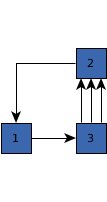 true | 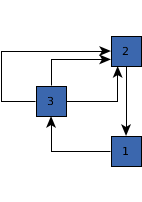 false |
protected EdgeLayoutDescriptor createEdgeLayoutDescriptor()
EdgeLayoutDescriptor instance that will be used during the various phases of the layout
algorithm to determine the drawing details of the edges of the graph.
This method may be overridden to create a new EdgeLayoutDescriptor instance with different configuration
settings.
null.EdgeLayoutDescriptor instancepublic EdgeLayoutDescriptor getEdgeLayoutDescriptor()
EdgeLayoutDescriptor instance used for all those edges that do not have a
specific layout descriptor assigned.
By default, this method will return an EdgeLayoutDescriptor instance created with
createEdgeLayoutDescriptor().
EdgeLayoutDescriptor instancesetEdgeLayoutDescriptor(EdgeLayoutDescriptor),
OrthogonalGroupLayouter.EDGE_LAYOUT_DESCRIPTOR_DPKEYpublic void setEdgeLayoutDescriptor(EdgeLayoutDescriptor edgeLayoutDescriptor)
EdgeLayoutDescriptor instance used for all those edges that do not have a
specific layout descriptor assigned.
EdgeLayoutDescriptoredgeLayoutDescriptor - the current EdgeLayoutDescriptor instance
java.lang.IllegalArgumentException - if the EdgeLayoutDescriptor is nullOrthogonalGroupLayouter.EDGE_LAYOUT_DESCRIPTOR_DPKEYpublic void setConsiderNodeLabelsEnabled(boolean enabled)
This method is a convenience method that assures that the
labeling algorithm is of type
LabelLayoutTranslator and LabelLayoutTranslator.setTranslateNodeLabelsEnabled(boolean) is set to
true.
enabled - true if the layout algorithm should take the node labels into account,
false otherwise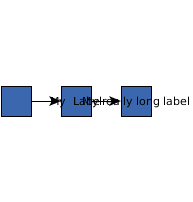 Node labels are not taken into account and layout orientation is left-to-right | 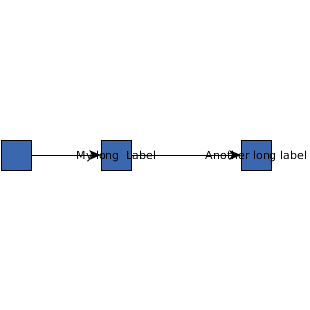 Node labels are not taken into account and layout orientation is left-to-right |
public boolean isConsiderNodeLabelsEnabled()
This method is a convenience method that assures that the
labeling algorithm is of type
LabelLayoutTranslator and LabelLayoutTranslator.setTranslateNodeLabelsEnabled(boolean) is set to
true.
true if the layout algorithm takes the node labels into account,
false otherwise
java.lang.IllegalStateException - if no properly configured LabelLayoutTranslator is registered even though
this property was enabled earlier (can happen when manually specifying
the labeling algorithm).setConsiderNodeLabelsEnabled(boolean)public boolean isPerceivedBendsOptimizationEnabled()
A perceived bend is not a real bend. A node with two incident edges induces a perceived bend if the edges are not placed on opposite sides. Enabling this option especially prevents a helical arrangement of chains of nodes.
true if the number of perceived bends is minimized, false otherwisesetPerceivedBendsOptimizationEnabled(boolean)public void setPerceivedBendsOptimizationEnabled(boolean perceivedBendsOptimizationEnabled)
A perceived bend is not a real bend. A node with two incident edges induces a perceived bend if the edges are not placed on opposite sides. Enabling this option especially prevents a helical arrangement of chains of nodes.
perceivedBendsOptimizationEnabled - true if the number of perceived bends should be minimized,
false otherwisepublic void setIntegratedEdgeLabelingEnabled(boolean enabled)
To define the desired placement for each label use PreferredPlacementDescriptor.
This method also assures that the labeling algorithm
is of type LabelLayoutTranslator and LabelLayoutTranslator.setTranslateEdgeLabelsEnabled(boolean)
is set to true.
labeling algorithm will be
overwritten and when disabling it, any currently specified labeling algorithm will be disabled via property
CanonicMultiStageLayouter.setLabelLayouterEnabled(boolean). Therefore, it is recommended to only use this convenience property
instead of manually changing the mentioned other properties.enabled - true if integrated edge labeling should be enabled, false otherwise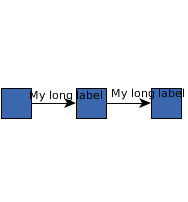 false |  true |
public boolean isIntegratedEdgeLabelingEnabled()
To define the desired placement for each label use PreferredPlacementDescriptor.
This method also assures that the labeling algorithm
is of type LabelLayoutTranslator and LabelLayoutTranslator.setTranslateEdgeLabelsEnabled(boolean)
is set to true.
labeling algorithm will be
overwritten and when disabling it, any currently specified labeling algorithm will be disabled via property
CanonicMultiStageLayouter.setLabelLayouterEnabled(boolean). Therefore, it is recommended to only use this convenience property
instead of manually changing the mentioned other properties.true if integrated edge labeling is enabled, false otherwise
java.lang.IllegalStateException - if no properly configured LabelLayoutTranslator is registered even though
integrated labeling was enabled earlier (can happen when manually specifying
the labeling algorithm).setIntegratedEdgeLabelingEnabled(boolean)public int getGrid()
Each node will be placed on a grid point. Edges will be routed such that their segments lie on grid lines, if possible.
setGrid(int)public void setGrid(int grid)
Each node will be placed on a grid point. Edges will be routed such that their segments lie on grid lines, if possible.
The grid spacing has to be greater than 0.
public boolean getUseSketchDrawing()
The layout algorithm will try to orthogonalize the given sketch without making too many modifications with respect to the original drawing.
true if the existing drawing is used as a sketch, false otherwisesetUseSketchDrawing(boolean)public void setUseSketchDrawing(boolean value)
The layout algorithm will try to orthogonalize the given sketch without making too many modifications with respect to the original drawing.
value - true if the existing drawing should be used as a sketch, false otherwisepublic boolean isUsePostprocessing()
true if the postprocessing step is applied, false otherwisepublic void setUsePostprocessing(boolean usePostprocessing)
public void setComponentLayouterEnabled(boolean enabled)
LayoutStage used for arranging the components of the graph is activated.
setComponentLayouterEnabled in class CanonicMultiStageLayouterDirectedOrthogonalLayouter can only handle single components. Disabling
ComponentLayouter will lead to errors during execution.enabled - true if the stage that arranges the graph components is activated, false
otherwiseCanonicMultiStageLayouter.isComponentLayouterEnabled(),
CanonicMultiStageLayouter.setComponentLayouter(LayoutStage),
ComponentLayouterpublic void setGroupNodeHidingEnabled(boolean groupNodeHidingEnabled)
LayoutStage used for hiding group nodes is activated.
setGroupNodeHidingEnabled in class CanonicMultiStageLayouterDirectedOrthogonalLayouter cannot handle group nodes. Disabling GroupNodeHider will lead
to errors during execution.groupNodeHidingEnabled - true if the stage used for hiding group nodes is activated,
false otherwiseCanonicMultiStageLayouter.isGroupNodeHidingEnabled(),
CanonicMultiStageLayouter.setGroupNodeHider(LayoutStage),
GroupNodeHiderpublic void doLayout(LayoutGraph graph)
doLayout in interface LayouterdoLayout in class CanonicMultiStageLayoutergraph - the input graphCanonicMultiStageLayouter.appendStage(LayoutStage),
CanonicMultiStageLayouter.prependStage(LayoutStage),
CanonicMultiStageLayouter.doLayoutCore(LayoutGraph)protected void doLayoutCore(LayoutGraph graph)
doLayoutCore in class CanonicMultiStageLayoutergraph - the input graphprotected boolean canLayoutCore(LayoutGraph graph)
canLayoutCore in class CanonicMultiStageLayoutergraph - the input graph
true for all input graphs
|
© Copyright 2000-2025, yWorks GmbH. All rights reserved. |
||||||||
| PREV CLASS NEXT CLASS | FRAMES NO FRAMES | ||||||||
| SUMMARY: NESTED | FIELD | CONSTR | METHOD | DETAIL: FIELD | CONSTR | METHOD | ||||||||